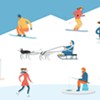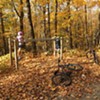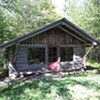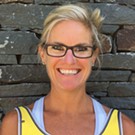Published June 8, 2005 at 4:00 a.m.
Ask Robert VanDerHeyden how much he knows about the sport of luge and he freezes up. "Just... uh, not much," says the Hinesburg 14-year-old, nervously eyeing the ersatz luge course on sloping Locust Street in Burlington. Robert's father, Glenn, is more forthcoming. "Our dream is for him to become an Olympic gold medalist," he says, adding that Robert was born in the U.S. Virgin Islands -- he could be the greatest sliding sensation since the Jamaican bobsled team that stormed the Calgary 1998 Olympic Winter Games. "He'd be a national hero," Glenn says.
VanDerHeyden's son is one of 16 or so young hopefuls who have turned out on a recent sunny Saturday morning for a chance to be groomed by the U.S. national luge team. The Slider Search -- now in its 20th year -- aims at those aged 11 to 14. That's young enough to start developing the necessary technical skills and old enough to leave home for a couple of weeks each winter. The Burlington event is the first of eight clinics that are expected to attract 500 to 1000 kids around the country. Sixty to 75 wannabe athletes will receive invitations in September to try out on the ice next winter. Of those, 10 will be named to the national development team.
Luge -- which is French for "sled" -- requires a harder pitch than other sports. Though it's been part of the Olympics since 1964, luging has received a chilly reception from American fans, who seem to prefer watching the speeding bullets of bobsleds or the twirling skirts of figure skaters. There are only two Olympic-level tracks in the country, at Park City, Utah, and Lake Placid -- home base for today's recruiters.
It's probably not a coincidence that no American has ever won a medal in singles luge. The doubles teams -- which are technically co-ed but have consisted only of men, who hook up in the sled with the aid of a strap -- have had better luck. At the Nagano 1998 Games, Mark Grimmette and Brian Martin took the bronze, while Christopher Thorpe and Gordon Sheer slid to silver. Thorpe, with teammate Clay Ives, was then third at the Salt Lake 2002 Games, while Grimmette and Martin moved up to silver. Since Thorpe, Sheer and Ives are all retired, Grimmette and Martin are the U.S.'s best bet for vittoria at the Torino Games in Italy next February.
"We're trying to put a face onto our organization, and it's Mark and Brian," says Jon Lundin, who handles public relations for USA Luge. Burlington's event focuses on finding fresher faces and on getting the next generation of potential sliders interested in a sport many of them know little about it. "For the most part these kids are being introduced to the sport of luge for the first time; everyone's on a really even playing field," says Lundin.
Locust Street is a good site for this athletic matchmaking. Its pitch is daunting, but it has no visible potholes -- only a raised crosswalk. Recruitment and development coach Pete Motta kindly points it out to the kids. "Be ready for a little bump," he says. "This is a little bit of a fast hill, so anytime you hear, 'Stop! Put your foot down!' that means, 'Stop! Put your foot down!'"
Motta also shows off some equipment -- aerodynamic booties, metal-spiked gloves and a tight suit. And he offers tips on steering the modified sleds with wheels, which resemble giant, belly-up beetles. He does not reveal the secret formula that will earn contenders an invitation to train on ice next winter. He has let me in on the secret, though. He's looking for a mix of coachability, balance, relaxation on the sled and general athletic ability -- to be tested later on a pull-up bar and obstacle course.
"It's a very natural thing, like a golf swing; some kids have it and some don't," says Motta, who also admits it can be difficult to pick a winner on the pavement. "Some kids look good out here, but then they'll get on the ice and be a disaster."
To prevent these kids from landing a ride to Fletcher Allen rather than the Olympics, orange cones and hay bales have been strategically placed around telephone poles and the trunks of maples and oaks. "It's amazing -- if there's a way to hit something, a kid always finds it," says Motta. "We say, 'Oh, that tree's 20 yards off to the side, we don't need to worry about it,' and they nail it."
My mind flashes back to the Salt Lake Games, when Iginia Boccalandro, a former Burlington resident competing for Venezuela, suffered a spectacular crash. Rounding a sharp curve on the track, she smashed into the wall, flew three feet into the air, flipped onto her stomach and then slithered to a stop while her sled kept going, slicing off the fingertip of an intervening volunteer.
"I'm a little nervous," says Emily Bestenbostel, 14, of Richmond, as we trudge up the hill pulling our sleds on their thin ropes. "I've never done this before." In spite of her jitters, she marches to the front of the line and is soon off. A little push from national luge team member Julia Clukey sends her back down the hill in a straight shot, interrupted only by a little scuffling of her sneakers as she stops before the bump.
By the time it's my turn, everyone else has already gone. They're giddily giving me tips on turning, and where to hold my hands so they don't get scorched by the wheels. Kody and Adam Corbosiero, 11-year-old twins from Shelburne, are already eyeing the steep sheet of metal that hangs off a van parked at the top of the street. Motta has mentioned that the sliders might get a chance to do down it if the morning progresses well. "I want to go off the ramp right now!" says Kody, who's fueled up with two waffles and a bowl of Corn Pops for the demands of luge. "It's an extremely fast sport -- you need a lot of muscle, and you've got to be one heck of a daredevil," he says.
I had eggs for breakfast, and as I lie down on my sled, they're not synchronizing so well with the gin and tonics I drank the night before at Breakwater. Lundin has told me that luge is the most technically demanding of the three sliding sports, and also the speediest. "Bobsled and skeleton, they'll reach speeds in the low 80s," he said. "We're in the mid-90s." Lest I forget this, Clukey is wearing a T-shirt that reads "The Fastest Sport on Ice." But I barely have time to register it as she instructs me to hang on, and then shoves me down the street.
I'm supposed to focus on keeping my head back and my toes pointed, but all I can think about are the nasty raspberries I'll get if I do a Boccalandro flip, or the nastier reception I'll receive if I hit Motta, who's evaluating performances mid-course. Just when I've managed to avoid the obstacles and start having fun, I'm done, my Adidas braking. National luge athlete Samantha Retrosi, who was recruited on this very street in 1997, is waiting for me at the bottom. "How'd I look?" I ask. She gives me a long glance, and then says reluctantly, "Um, good." Clearly, I did not have the right stuff.
Lots of the Locust Street sledders do, though. Motta says he likes what he's seen. "This is a good clinic," he says. "I would say about half is promising."
Glenn VanDerHeyden is also encouraged. For the last run, Motta gives the kids the option of sliding from the top of the ramp, and nobody turns him down. As Robert VanDerHeyden climbs the ladder, his father leans in to murmur, "Go straight down the hill, that's what they're going to look at. This is your final chance."
Robert whizzes by at 30 miles an hour. "Nice, nice... that looked good, didn't it?" says Glenn. "Aw, look at me, I've got goosebumps."
More By This Author
Speaking of...
-

Michael Krasnow Has Spent Decades Giving Kids Skis, Snowboards and a Taste of Independence
Jan 31, 2024 -

Video: Ice Fishing for Rainbow Smelt in Plymouth With Zachary and Fisher McNaughton and Fish Biologist Shawn Good
Feb 9, 2023 -

Video: Youths Compete in a Turkey Calling Contest in Castleton
Apr 21, 2022 -

Essay: Learning to Ice Skate Is Easier Than You Think
Dec 7, 2021 -

What Can I Do to Get More Hang Time With My Ski-Bunny Buds?
Nov 10, 2021 - More »
Comments
Comments are closed.
From 2014-2020, Seven Days allowed readers to comment on all stories posted on our website. While we've appreciated the suggestions and insights, right now Seven Days is prioritizing our core mission — producing high-quality, responsible local journalism — over moderating online debates between readers.
To criticize, correct or praise our reporting, please send us a letter to the editor or send us a tip. We’ll check it out and report the results.
Online comments may return when we have better tech tools for managing them. Thanks for reading.














































